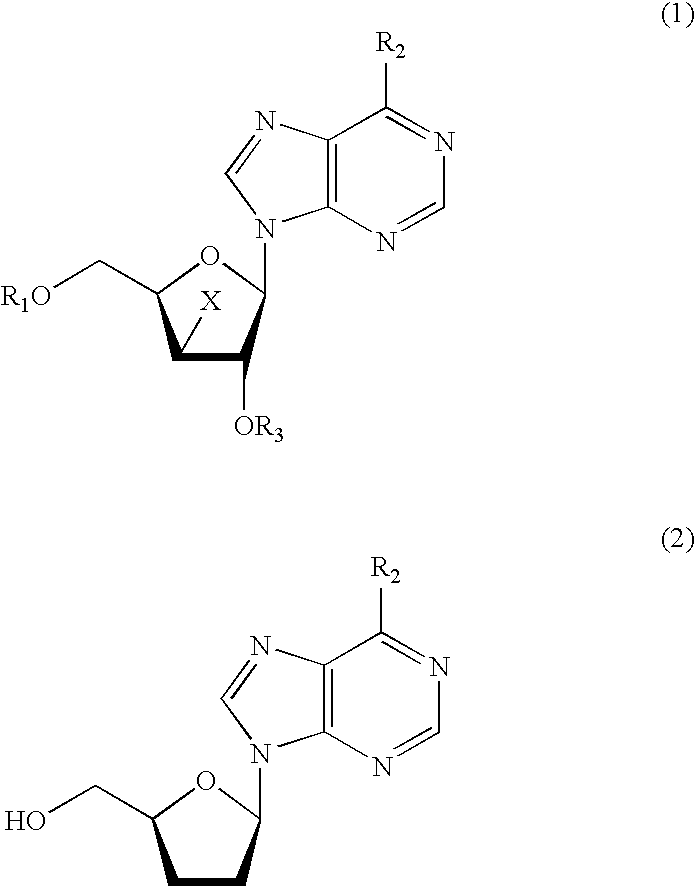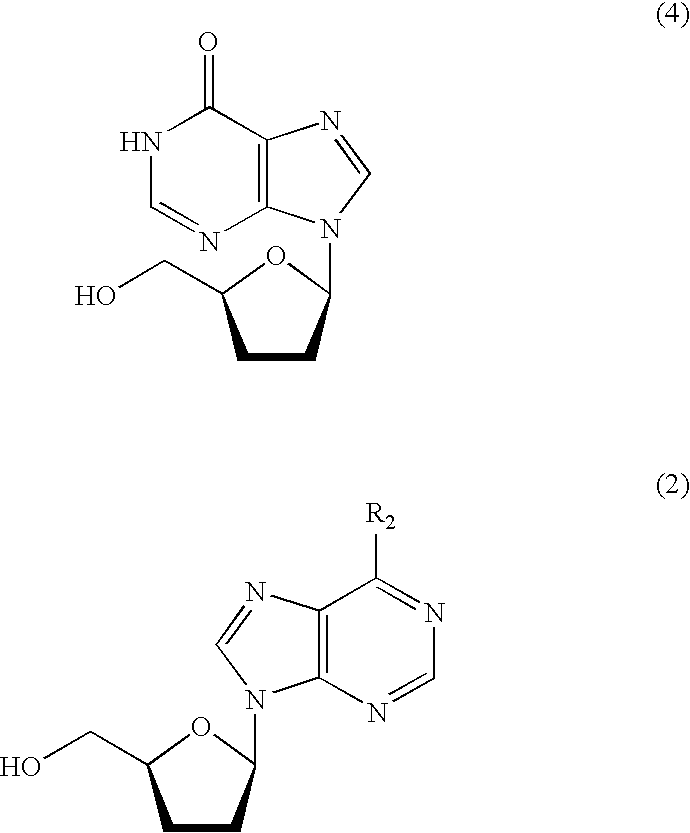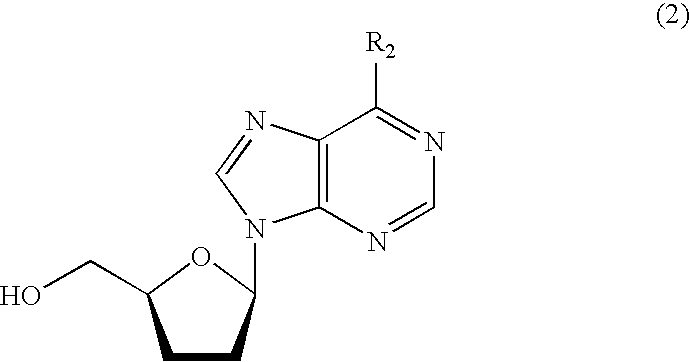Method for producing nucleoside derivatives
a nucleoside derivative and nucleoside technology, applied in the field of nucleoside derivative production, can solve the problems of difficult to use catalysts in large quantities and the cost of catalysts themselves, and achieve the effects of short reaction time, reduced impurities in the resultant dda and ddi, and convenient procedures
- Summary
- Abstract
- Description
- Claims
- Application Information
AI Technical Summary
Benefits of technology
Problems solved by technology
Method used
Image
Examples
examples
[0066]Examples and Comparative Examples Employed the Following Catalysts:
[0067]Catalyst (A): 10% palladium on carbon catalyst (Wet), made by Kawaken Fine Chemicals Co., Ltd. (a homogeneously supported type catalyst where the specific surface area of the noble metal is 120 m2 / g, the particle size of the noble metal is 3.5 nm, and the dispersion degree of the noble metal is 27.0%)
[0068]Catalyst (B): 10% palladium on carbon catalyst (Wet), made by Kawaken Fine Chemicals Co., Ltd. (a surface-loaded type catalyst where the specific surface area of the noble metal is 104 m2 / g, the particle size of the noble metal is 4.0 nm, and the dispersion degree of the noble metal is 23.3%)
[0069]Catalyst (C): 10% palladium on carbon catalyst (Wet), made by Kawaken Fine Chemicals Co., Ltd. (a homogeneously supported type catalyst where the specific surface area of the noble metal is 67 m2 / g, the particle size of the noble metal is 6.2 nm, and the dispersion degree of the noble metal is 15.1%)
[0070]Cata...
example 1
[0071]After 368 g of a mixed solution of acetonitrile and water containing 19.4 wt % of 9-(2,5-O-diacetyl-3-bromo-3-deoxy-β-D-xylofuranosyl)adenine (71.4 g, 172 mmol) was poured into a 500-ml eggplant-shaped flask, the solution was adjusted to the pH range of 8.5 to 10.5 by the addition of aqueous sodium hydroxide solution. Thereafter, the catalyst (A) was added in an amount of 10.9 g (0.028 equivalent on a basis of palladium atom) and hydrogen was blown into the reaction system to carry out a reduction reaction, with the reaction system being maintained under basic condition by use of aqueous sodium hydroxide solution. The reduction reaction was completed in 5.5 hours.
[0072]After completion of the reduction, the reaction liquid was subjected to filtration to remove the catalyst, and thereafter subjected to saponification by the addition of aqueous sodium hydroxide solution. According to the quantitative analysis by HPLC, 2′,3′-dideoxyadenosine was found to be obtained in a yield of...
example 2
[0073]9-(2,5-O-diacetyl-3-bromo-3-deoxy-β-D-xylofuranosyl)adenine was subjected to the reduction reaction in the same manner as in Example 1 except that the catalyst (B) was used in an amount of 10.0 g (0.028 equivalent on a basis of palladium atom). The reduction reaction was completed in 4.5 hours.
[0074]After completion of the reduction, the reaction liquid was subjected to filtration to remove the catalyst, and thereafter subjected to saponification by the addition of aqueous sodium hydroxide solution. According to the quantitative analysis by HPLC, 2′,3′-dideoxyadenosine was found to be obtained in a yield of 84%.
[0075]Further, 0.4% of 2′,3′-didehydroxy-2′,3′-epoxyadenosine was included as impurities.
PUM
| Property | Measurement | Unit |
|---|---|---|
| particle size | aaaaa | aaaaa |
| specific surface area | aaaaa | aaaaa |
| particle size | aaaaa | aaaaa |
Abstract
Description
Claims
Application Information
 Login to View More
Login to View More - R&D
- Intellectual Property
- Life Sciences
- Materials
- Tech Scout
- Unparalleled Data Quality
- Higher Quality Content
- 60% Fewer Hallucinations
Browse by: Latest US Patents, China's latest patents, Technical Efficacy Thesaurus, Application Domain, Technology Topic, Popular Technical Reports.
© 2025 PatSnap. All rights reserved.Legal|Privacy policy|Modern Slavery Act Transparency Statement|Sitemap|About US| Contact US: help@patsnap.com



